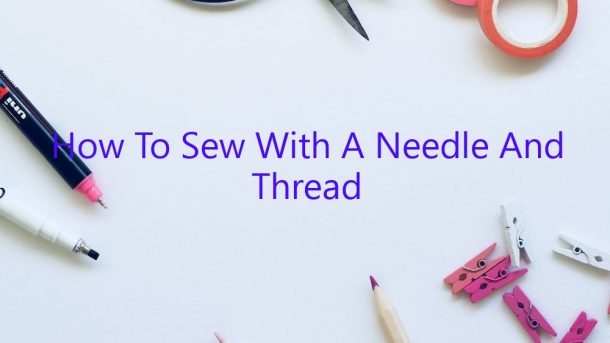Sewing might seem like an intimidating task, but with a little practice, it’s easy to learn how to do. In this article, we’ll teach you the basics of sewing with a needle and thread.
To start, you’ll need a few supplies. You’ll need a needle and thread, of course, as well as a pair of scissors and a ruler. If you’re working with a fabric that has a right and wrong side, make sure you orient the fabric so that the right side is facing up.
Next, you’ll need to thread the needle. To do this, pass the thread through the eye of the needle. Then, hold the thread taut and make a small loop, or knot, at the end. This will keep the thread from unraveling.
Now, it’s time to start sewing. Begin by positioning the fabric so that the needle is at the edge of the fabric, and the thread is hanging off the edge. Then, insert the needle into the fabric and pull the thread taut.
Next, make a small stitch by moving the needle up and down. Be careful not to pull the thread too tight, or you’ll distort the fabric. Instead, allow the fabric to “give” a little as you sew.
Continue making small stitches until you’ve sewn a line the length of the fabric. Then, tie a knot in the thread to secure it, and cut the excess thread.
That’s all there is to it! With a little practice, you’ll be able to sew like a pro.
Contents
How do you set up a needle and thread?
A needle and thread is a handy tool to have around when you need to mend something. It can be a little tricky to set up at first, but with a little practice, you’ll be able to do it like a pro. Here’s how:
First, take the needle and thread and tie a knot in the end of the thread. This will keep it from coming undone.
Then, thread the needle. You can do this by holding the thread between your thumb and first two fingers and pulling it through the eye of the needle.
Once the needle is threaded, you’re ready to start sewing. Put the fabric you’re sewing together under the needle and push the needle through the fabric. Then, pull the thread tight. Keep doing this until you’ve sewn the entire length of the fabric.
When you’re done, tie a knot in the end of the thread to keep it from coming undone.
How do you hand sew with a needle for beginners?
If you want to sew by hand, you’ll need a needle and thread. There are many different types of needles and threads, so it’s important to select the right ones for the project you’re working on.
Thread comes in different weights, or thicknesses. The most common weights are fine, medium, and heavy. Heavier threads are best for projects that need a lot of strength, like leather or denim. Fine threads are best for delicate fabrics, like silk or chiffon.
There are also many different types of needles. The most common are sharps, betweens, and quilting needles. Sharps needles are best for general sewing projects. Betweens needles are thin and have a small eye, making them perfect for sewing between the threads of delicate fabrics. Quilting needles have a large eye and a sharp point, making them perfect for piecing together quilts.
Once you’ve selected the right thread and needle for your project, it’s time to start sewing.
To hand sew with a needle, follow these steps:
1. Tie a knot in the end of the thread.
2. Insert the needle into the fabric.
3. Pull the thread through the fabric.
4. Repeat steps 2 and 3 until you’ve sewn the desired length.
5. Tie a second knot in the end of the thread to secure it.
How do you sew step by step?
Sewing is a common household activity that can be used to create a variety of different items. Whether you are new to sewing or have been practicing for years, learning how to sew step by step can be a helpful guide.
The first step in sewing is to choose the right fabric. Not all fabrics are created equal, so it is important to select a fabric that is suitable for the project you are working on. You will also need to consider the weight and thickness of the fabric.
Once you have chosen the right fabric, it is time to cut it to the correct size. Use a fabric marker or pencil to trace the pattern onto the fabric. Be sure to leave an extra inch around the edges for seam allowances.
Next, use a pair of sharp scissors to cut out the fabric. Be careful not to cut too close to the markings, as you will need the extra fabric for sewing.
The next step is to sew the fabric together. This can be done using a sewing machine or by hand.
If you are using a sewing machine, the following steps will help you to sew the fabric together correctly.
First, thread the sewing machine with the appropriate color of thread. Be sure to match the thread to the fabric.
Next, place the fabric wrong sides together. This means that the wrong sides of the fabric will be facing each other.
Then, use the sewing machine to sew the fabric together. Be sure to start and stop at the markings, and use a backstitch to secure the stitches.
If you are sewing by hand, the following steps will help you to sew the fabric together correctly.
First, knot the thread at the beginning and end of the seam.
Then, place the fabric wrong sides together. This means that the wrong sides of the fabric will be facing each other.
Next, use a running stitch to sew the fabric together. Be sure to start and stop at the markings, and use a knot to secure the stitches.
Finally, press the seam open. This means that you will press the fabric flat so that the two pieces are no longer overlapping.
If you are new to sewing, it is a good idea to practice on a piece of scrap fabric before starting your project. This will help you to become familiar with the steps involved in sewing.
Do you sew with needle up or down?
There are different ways to sew, and the way you sew can affect the finished product. One question you may have is whether to sew with the needle up or down.
Sewing with the needle up means that the needle is going into the fabric from the top side. Sewing with the needle down means that the needle is going into the fabric from the bottom side.
There are pros and cons to both methods. Sewing with the needle up can be a bit more difficult because you have to be careful not to hit the needle with your fingers. However, it can be easier to see what you’re doing because you’re looking at the top of the fabric.
Sewing with the needle down can be a bit more dangerous because the needle is going into the fabric closer to your fingers. However, it can be easier to control the fabric because you’re looking at the bottom side.
In the end, it’s up to you which method you use. Try both methods and see which one you prefer.
What’s the easiest way to thread a needle?
There are many ways to thread a needle, but some ways are definitely easier than others. Here is a list of the easiest ways to thread a needle:
1. Use a needle threader. This is a small, metal device that has a loop on one end and a small, sharp wire on the other. You put the thread through the loop, and then use the wire to guide it through the eye of the needle.
2. Use a wire. This is a method that is similar to using a needle threader, but you use a piece of wire instead of a metal loop.
3. Use a length of thread. This is the easiest way to thread a needle if you have a lot of thread and a steady hand. Start by tying a knot in the end of the thread. Then, hold the thread between your thumb and first two fingers. Use your other hand to guide the needle and insert the eye of the needle into the loop of thread. Gently pull the thread through the needle’s eye.
How do you secure a thread to a needle?
Pinpointing the end of a thread and securing it to the eye of a needle can be a frustrating task. It is a process that takes patience and practice. There are a few different ways to do this, but all require a steady hand and some dexterity.
One way to secure a thread to a needle is to use a small piece of tape. Place a piece of tape on the end of the thread and then press it against the eye of the needle. Be sure to press the tape against the needle firmly so that it will stay in place.
Another way to attach a thread to a needle is to use a small piece of wax. Cut a small piece of wax from a candle and press it against the end of the thread. Then, press the wax against the eye of the needle. The wax will help to secure the thread in place.
A third way to attach a thread to a needle is to use a small piece of glue. Apply a small amount of glue to the end of the thread and press it against the eye of the needle. The glue will help to keep the thread in place.
All of these methods require a little practice, but eventually you will be able to attach a thread to a needle with ease.
How can I learn to sew at home for beginners?
Sewing is a fun and useful hobby that can be enjoyed by people of all ages. If you’re interested in learning how to sew at home, there are a few things you’ll need to know. In this article, we’ll discuss the basics of sewing and provide some tips for getting started.
Sewing is a process that involves using a needle and thread to join fabric together. It can be used to create a variety of items, including clothes, accessories, and home decor. In order to learn how to sew, you’ll need to have some basic knowledge of the craft. You’ll also need some basic supplies, including a sewing machine, fabric, thread, scissors, and a needle.
If you’re just starting out, it might be a good idea to take a sewing class or workshop. There are also a number of online tutorials that can teach you the basics of sewing. Once you have a basic understanding of the craft, you can start practicing on your own.
One of the best ways to improve your sewing skills is to find a project that you’re interested in and challenge yourself to complete it. You can also join a sewing community or online forum to get feedback and advice from other sewers.
If you’re looking for some inspiration, here are a few project ideas to get you started:
-sew a simple skirt
-sew a tote bag
-sew a pillowcase
-sew a sheet set
-sew a baby blanket




